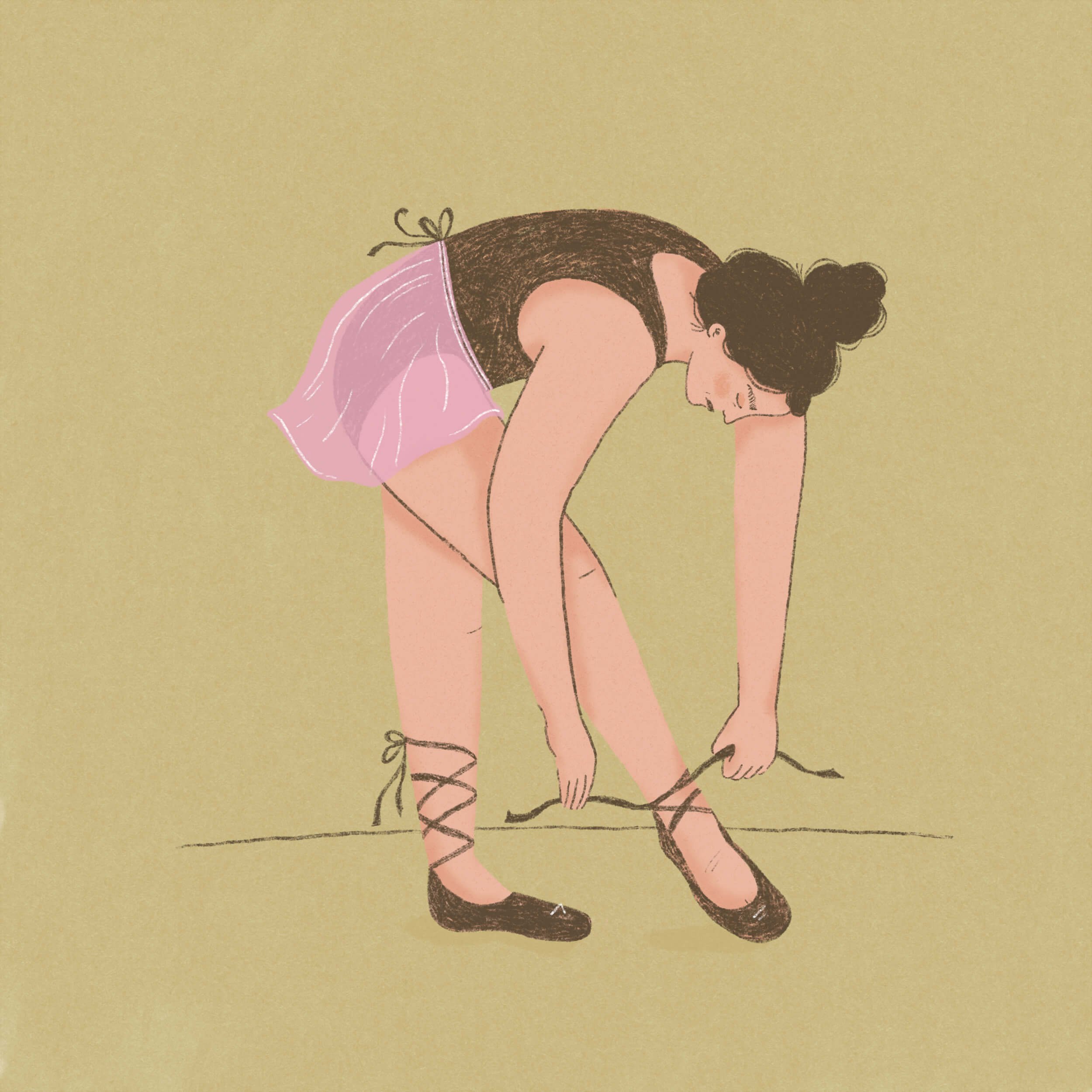Healing my relationship with dance
Illustrations by Martha Bräuer
by Tessa Kauppila
Our nonprofit generates funding in multiple ways, including through affiliate linking. When you purchase something through an affiliate link on this site, the price will be the same for you as always, but we may receive a small percentage of the cost.
Black leotard. Pink tights. A slicked-back bun. This was the uniform of my youth, first donning it once a week at a beginner ballet class and later, from ages 12 to 18, nearly every day as a member of my studio’s pre-professional contemporary dance company.
Dance, for me, was the pursuit of perfection. What I loved more than anything, even more than basking under the stage lights, was the time in the studio working, sweating, perfecting. We’d drill combinations at the barre or choreography in an ensemble, detailing it down to our eye movements and finger placements — and I loved it. Control under the guise of artistry.
I derived a lot of validation and self-worth from my excellence at dance, craving praise from my directors and choreographers and finding a high when I received it. The more solo parts I was cast in, the more exclusive summer training programs I was accepted into, the more I wanted to achieve.
Perfectionism is multidimensional, but can commonly be defined as "the setting of excessively high standards of performance in conjunction with a tendency to make overly critical self-evaluations." For me and many others, perfectionism nurtures drive and determination but can also lead to the rise in criticism, doubts, and a sense of inadequacy.
Studies show that more perfectionistic people (including many young elite athletes) report lower levels of self-esteem and self-confidence, higher levels of anxiety, and higher rates of disordered eating. Other studies illustrate that perfectionists are at a greater risk of experiencing burnout as a result of their commitment, exhibiting physical and emotional exhaustion, performance decline, and a less enamored view of their activity.
Martha Bräuer
It was these very burnout symptoms — fatigue, a performance plateau, and a more tepid attitude toward dance — that led me to quit pursuing it despite acceptance into a few reputable college programs and what may have been a promising career ahead.
At school, with a major that didn’t require a plethora of leotards, I joined a casual dance group, full of peers with similar intense dance training backgrounds. While it was a wonderful community-oriented creative outlet, I felt frustrated as I lost technique without the strenuous daily classes and rehearsals of my past. No longer was my identity so closely entwined with that of being “a dancer” and, even though this reinvention was what I wanted, I was having a hard time coping.
I let my time in the extracurricular group fizzle, accelerated by COVID-19 requiring all campus-related activities to operate via Zoom. I took this as a sign to cut out dance completely, opting for running, HIIT workouts, yoga, cycling... anything else. If I wasn’t going to be a capital-D Dancer, I wasn’t going to dance at all.
More than a year had passed without pirouettes and moving to 8-counts when a coworker mentioned an all-levels dance class she’d loved attending. Intrigued, I gave the group’s Instagram a follow, but still spent months marking class dates down and then letting them pass by.
That is, until one recent plan-less Friday evening. In a burst of confidence and curiosity, I showed up solo.
Here, I felt all my accumulated tension and resentment with dance dissolve. In that room — with non-uniformed bodies moving in their own distinctive ways — I decided that dance was more than a quest to be perfect. In fact, that’s not what it’s about at all.
To dance is to find release and freedom. To embrace community and individuality. To be both vulnerable and courageous. There’s something so bold and empowering about taking up space in every direction with velocity and purpose. Not once in that class did I feel a need to achieve perfection.
It’s no wonder dance is used as a healing modality. Dance/movement therapy, which falls under the creative arts therapies (alongside art and music), uses movement and body awareness to heal — on a mental, emotional, and sometimes spiritual level.
Martha Bräuer
"Rebuilding and re-establishing one's relationship to themselves through their body is really important,” says dance/movement therapist Kayla Jewette, LCAT, BC-DMT, who primarily works with young adults experiencing anxiety, depression, or trauma. “In Western society, there's such a disconnect because everyone's on the go… We don't have a lot of time to connect to ourselves. Connecting to your own body, your own rhythm, is healing within itself."
As for group dance classes, Jewette says, “There's something about that collective body work that's happening that can be really healing and validating. To be in the space with other people, sharing energy, sharing the floor, and just letting your body take over."
Not to mention the physical benefits. Studies reveal that dance, even at amateur levels of participation, improves body composition, blood biochemistry, and the musculoskeletal system, and is equivalent to (or even, once in a while, more effective than) other structured physical activity in regard to cardiovascular function and self-perceived mobility.
And so, as I left class the other day, sweaty and smiling, I couldn’t help but reflect on my long-and-sometimes-rocky relationship with dance and swell with immense gratitude for its 360° evolution. I dance for the very simple reason my parents enrolled me in toddler ballet class long ago: fun.


